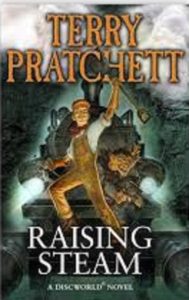Book Review: Raising Steam by Terry Pratchett
Moist von Lipwig has come a long way since his days as a petty con artist. He’s a (mostly) respectable married man who manages the Ankh-Morpork Post Office, Mint, and Bank. True, his management is mostly just taking a friendly interest in the employees who do all the actual work, but the system produces good results. Things could certainly be worse.
Moist’s employer, the Patrician of Ankh-Morpork, is quick to remind him of this–Lord Vetinari could at any time reinstate the sentence of death brought about by Moist’s former crimes. Which is why the Patrician trusts that Moist will not fail him in this new assignment.
It seems a young engineer named Dick Simnel has devised a way to make steam power a device that move on rails. A railroad, if you will. Mr. Simnel has a dream of using this steam engine to move objects from one place to another very quickly, and building more such engines in great number. The Patrician has taken an interest in this new technology, and wants Moist to make sure it works to the advantage of Ankh-Morpork.
The task is not without its hazards. It may be “steam engine time”, but there are those who have had enough of change and progress. They want to go back to the days of darkness, even if they have to drag everyone else along with them through terrorism.
This is the next to last Discworld novel. In the previous volume, Snuff, the goblins became recognized as people. Odd people, but aren’t everyone? Now they’re a part of Ankh-Morpork culture, and fitting in just fine. They seem to have a knack for working with engines.
The focus species (besides the usual humans) are the dwarves. The grags, a reactionary and somewhat mystical group within their ranks, don’t like the changes they see in dwarf society. Living above ground! Treating humans and trolls as equals! Having genders! And worst of all, not treating the grags as the final authority on dwarf culture! They’ve managed to radicalize some of the younger dwarves into becoming terrorists for their cause of reversing progress.
The battle against the grags is a relatively minor part of the plot, which is mostly about how awesome steam engines and the railroads are, and the difficulties involved in getting a rail network established. Sir Terry’s research and love of all things rail shines through as the various characters learn to appreciate this new technology.
Good stuff: Again, love of steam railroads shines throughout the book and is infectious. In its way, this is a Utopian work. The future will be better than the past. Properly used technology makes people’s lives more enjoyable. Society can improve, becoming more inclusive and less violent. Change can be good, and those that refuse to change will be left in the dust.
As Terry Pratchett was aware he was dying while writing this book, it’s also a fond farewell to many of the continuing characters. I was particularly struck by how many healthily married couples appear. Too often in fantasy, marriage is the end of a character’s story arc and relevance. Here, we actually see “happy ever after.”
‘Scuse me, I’m tearing up again.
Despite the fact that technology is the centerpiece of this story and ascendant, this is also still very much a fantasy world, and the magic of the setting is important.
Less good: At times, this book comes off a little too much like a victory lap. The heroes have done this sort of thing before, and there isn’t a lot of suspense about whether they’ll succeed this time. Some passages skirt dangerously close to “when the villains kill it’s murder, when the heroes kill, it’s justice.”
I would not recommend this as anyone’s first Discworld novel. Too much of the emotional resonance comes from having met these characters before and living through their past struggles with them. Several cameo appearances will make no sense to new readers.
That said, this is a fine capstone to the Ankh-Morpork storylines of the Discworld series. (The final volume, The Shepherd’s Crown, takes place in more remote territory and stars young witch Tiffany Aching.)
You know what, let’s look at some old steam engines in action.

